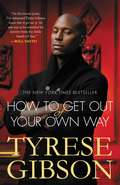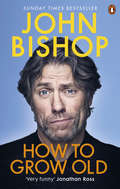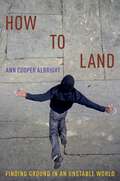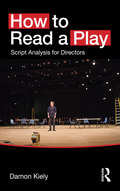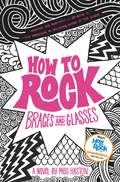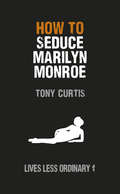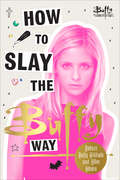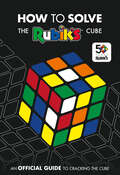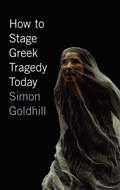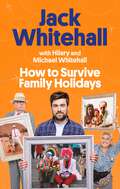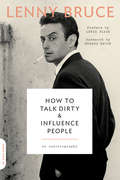- Table View
- List View
How to Get Out of Your Own Way
by Tyrese GibsonThe New York Times bestselling "road map of conscious compassion and love" (Deepak Chopra) from actor, singer, songwriter Tyrese Gibson.Organized as a series of fundamental questions that helped Tyrese redefine who he was as a human being, and evolve into a new man, How To Get Out of Your Own Way is a guide to helping yourself, using his experiences as a learning tool. "It's not about talking down to people, it's about elevating them," Tyrese says, stressing that life becomes infinitely richer when one takes the time to know oneself and understand the true meaning of peace and fulfillment. Some of Tyrese's chapter-based questions include: How much do you love yourself? How much do you want for yourself? Why do men cheat? What is your bottom line? Are you ready for the next level?With personal experiences paired with reflective questions based on his extremely popular blog piece, "The Love Circle", Tyrese hopes to inspire readers to pursue their dreams and not let life's obstacles stand in the way."A triumph. Tyrese will shock and amaze you with how he overcame the odds and became a superstar." --Rev Run"I've watched Tyrese for many years -- I've watched him succeed; I've watched him fail; I've seen him as a beneficiary of serendipity, and I've watched him suffer at his own hand. And in the recent years, as we've become friends, I've witnessed Tyrese Gibson learn how to get out of his own way." --Will Smith
How to Grow Old: A middle-aged man moaning
by John BishopIntimate confessions and spit-your-dentures-out hilarious commentary – this is observational comedy at its best.How to Grow Old is a stupid title, because the answer is obvious: Don’t Die. Provided you don’t die, you are growing old.Don’t come to this book under any illusions. It isn’t going to tell you how to stay alive any longer. It won’t help you understand the aging process from a sociological and anthropological perspective, and I’m not sure how much practical advice you’re going to get. However, if you happen to want to know what a white, heterosexual, middle-aged man thinks of getting old – from the struggle to stay fit, keep hold of your friends or stay relevant, to why I’m better at doing a dump now than at any time in my life – this book could very well be exactly what you have been looking for. You might even find it a bit funny.
How to Land: Finding Ground in an Unstable World
by Ann Cooper AlbrightHow to Land: Finding Ground in an Unstable World foregrounds the importance of embodiment as a means of surviving the disorientation of our twenty-first century world. Linking somatics and politics, author Ann Cooper Albright argues that a renewed attention to gravity as both a metaphoric sensibility and a physical experience can help transform moments of personal disorientation into an opportunity to reflect on the important relationship between individual resiliency and communal responsibility. Long one of the nation's preeminent thinkers in dance studies, Albright asks how contemporary bodies are affected by repeated images of falling bodies, bombed-out buildings, and displaced peoples, as well as recurring evocations of global economies and governments in discursive free fall or dissolution. What kind of fear gets lodged in connective tissue when there is an underlying anxiety that certain aspects of our world are in danger of falling apart? To answer this question, she draws on analyses of perception from cognitive studies, tracing the discussions of meaning, body and language through the work of Sara Ahmed, Jean-Luc Nancy, and Shaun Gallagher, among others. In addition, she follows the past decade of debate in contemporary media concerning the implications of the weightless and two-dimensional social media exchanges on structures of attention and learning, as well as their effect on the personal growth and socialization of a generation of young adults. Each chapter interweaves discussions of movement actions with their cultural implications, documenting specific bodily experiences and then tracing their ideological ripples out through the world.
HOW TO LAND C: Finding Ground in an Unstable World
by Ann Cooper AlbrightHow to Land: Finding Ground in an Unstable World foregrounds the importance of embodiment as a means of surviving the disorientation of our twenty-first century world. Linking somatics and politics, author Ann Cooper Albright argues that a renewed attention to gravity as both a metaphoric sensibility and a physical experience can help transform moments of personal disorientation into an opportunity to reflect on the important relationship between individual resiliency and communal responsibility. Long one of the nation's preeminent thinkers in dance studies, Albright asks how contemporary bodies are affected by repeated images of falling bodies, bombed-out buildings, and displaced peoples, as well as recurring evocations of global economies and governments in discursive free fall or dissolution. What kind of fear gets lodged in connective tissue when there is an underlying anxiety that certain aspects of our world are in danger of falling apart? To answer this question, she draws on analyses of perception from cognitive studies, tracing the discussions of meaning, body and language through the work of Sara Ahmed, Jean-Luc Nancy, and Shaun Gallagher, among others. In addition, she follows the past decade of debate in contemporary media concerning the implications of the weightless and two-dimensional social media exchanges on structures of attention and learning, as well as their effect on the personal growth and socialization of a generation of young adults. Each chapter interweaves discussions of movement actions with their cultural implications, documenting specific bodily experiences and then tracing their ideological ripples out through the world.
How to Make Great Radio: Techniques and Tips for Today's Broadcasters and Producers
by David LloydThere is no such thing as perfect radio - and therein lies its delicious unpredictability. In fact, so charming is this quality that 90 per cent of UK adults tune into the medium every week. Like many things, radio done well sounds effortless. It is not. Producing great radio is partly down to instinct and partly down to learning then mastering the basics. Drawing upon his thirty years spent working with some of the finest talents in British radio, David Lloyd shares a plethora of valuable tips and tricks of the trade in this unique and authoritative guide to broadcasting success. Covering speech and music formats, local and national stations, technical and artistic skills, content and style considerations, and much, much more, this how-to is essential and accessible reading for all - whether you are taking your tentative first steps in radio or refreshing your existing industry knowledge. Lloyd's hugely entertaining selection of anecdotes, examples, research, insight and pointers sets out to bottle the very essence of memorable radio, determining the factors that differentiate a truly great broadcaster from a distinctly average one, and helping budding hopefuls achieve their radio goals.
How to Market the Arts: A Practical Approach for the 21st Century
by Jay Pension Anthony S. RhineConventional business marketing often suggests that the primary function of business is to market a product in order to maximize efficiency and profit. In How to Market the Arts: A Practical Approach for the 21st Century, expert authors Anthony Rhine and Jay Pension propose a new paradigm to better explain how nonprofit arts marketing can and should work. How to Market the Arts provides a history of both nonprofit arts and critical marketing concepts to show how standard methods of marketing are ill-suited for the nonprofit arts industry. Through visual models and case studies of several arts organizations, the book offers instead a practical look at how this industry might adopt more holistic marketing strategies that better reflect their true function which is often to serve communities over persuading consumers. Rhine and Pension offer a theoretical framework for reconsidering the nature of nonprofit arts marking, as well as useful steps an organization might take to increase its value to a community and develop a broader audience base.
How to Market the Arts: A Practical Approach for the 21st Century
by Anthony S. Rhine Jay PensionConventional business marketing often suggests that the primary function of business is to market a product in order to maximize efficiency and profit. In How to Market the Arts: A Practical Approach for the 21st Century, expert authors Anthony Rhine and Jay Pension propose a new paradigm to better explain how nonprofit arts marketing can and should work. How to Market the Arts provides a history of both nonprofit arts and critical marketing concepts to show how standard methods of marketing are ill-suited for the nonprofit arts industry. Through visual models and case studies of several arts organizations, the book offers instead a practical look at how this industry might adopt more holistic marketing strategies that better reflect their true function which is often to serve communities over persuading consumers. Rhine and Pension offer a theoretical framework for reconsidering the nature of nonprofit arts marking, as well as useful steps an organization might take to increase its value to a community and develop a broader audience base.
How to Produce a West End Show
by Julius Green‘There’s no business like show business...’ How to Produce a West End Show demystifies the working world of live theatre. This is an insider account that maps an entry route into the industry and examines the challenges faced by West End producers. • How to budget and finance a show • How to assemble a cast and creative team • How to work with writers, directors and designers • How to book a West End theatre and a pre-West End tour • How to advertise and market your show A compelling read for anyone who works in or is interested in the theatre.
How to Read a Play: Script Analysis for Directors
by Damon KielyThe work done on a play before the first rehearsal, the first group reading or even the before the cast have met, can be crucial to the success of a production. Directors and dramaturgs must know how to analyze, understand and interpret a play or performance text if they hope to bring it to life on the stage. This book provides a broad range of tools and methods that can be used when reading a text, including: Lessons from the past. What can we learn from Aristotle, Stanislavsky, Meyerhold, Vakhtangov, Brecht and Harold Clurman? This section establishes the models and methods that underpin much of a director’s work today. A survey of current practices in Western theatre. A combination of research, interviews and observation of practical work addresses the main stages in understanding a play, such as getting to know characters, sharing ideas, mapping the action and grappling with language. A workbook, setting out twenty one ways of breaking down a play, from the general to the particular. Contributions, reflections and interjections from a host of successful directors make this the ideal starting point for anyone who wants to direct a play, or even devise one of their own. This wide range of different approaches, options and techniques allows each reader to create their own brand of play analysis.
How to Read a Play: Script Analysis for Directors
by Damon KielyThe work done on a play before the first rehearsal, the first group reading or even the before the cast have met, can be crucial to the success of a production. Directors and dramaturgs must know how to analyze, understand and interpret a play or performance text if they hope to bring it to life on the stage. This book provides a broad range of tools and methods that can be used when reading a text, including: Lessons from the past. What can we learn from Aristotle, Stanislavsky, Meyerhold, Vakhtangov, Brecht and Harold Clurman? This section establishes the models and methods that underpin much of a director’s work today. A survey of current practices in Western theatre. A combination of research, interviews and observation of practical work addresses the main stages in understanding a play, such as getting to know characters, sharing ideas, mapping the action and grappling with language. A workbook, setting out twenty one ways of breaking down a play, from the general to the particular. Contributions, reflections and interjections from a host of successful directors make this the ideal starting point for anyone who wants to direct a play, or even devise one of their own. This wide range of different approaches, options and techniques allows each reader to create their own brand of play analysis.
How to Rock Braces and Glasses (How To Rock Ser. #1)
by Meg HastonRead the book that inspired the Nickelodeon TV show! Perfect for fans of Middle School and Awkward. Super-stylish and uber-harsh, Kacey Simon is the social dictator of Marquette Middle School. But when an eye infection and a visit to the dentist leave her with giant glasses, a mouth full of metal, and...a littthp, Kacey is dismissed by her popular friends, falling so far down the social ladder she can barely see the top, even with her magnifying specs. With nowhere else to turn, Kacey has to hang with her nerdy neighbor and a boy who walks to beat of his own drum, but she's determined to reclaim her throne. Will she climb back to the top? Or will she discover that hitting rock bottom kind of...rocks?
How to Run an Indie Label
by Alan McGeeMusic is like no other business. It's about being at the right place at the right time, following your nose and diving in feet first. It's about being plugged into the mystical electricity and about surfing on the wild energy. It's about how to fuck up and how to survive and be sustained by the holy grail of the high decibel.No-one captures this wild feral spirit better than Alan McGee whose helter skelter career through music has made him a major force. Wilder than his bands, more out of control than his most lunatic singer, more driven than his contemporaries and closer in spirit to the rock n roll star he could never be himself, McGee was always in a rush. Creation would sign people and not just the music. McGee understood that running an indie label is mainly about the charisma, the game changers, the iconography and the story. It's about never being boring.His ability to start a raw power ruckus brought the visceral danger back to a moribund mid-eighties music scene. His nose for danger and his ear for classic guitar rock n roll brought us Jesus and Mary Chain, Primal Scream, My Bloody Valentine, Teenage Fan Club and Ride before topping out in the nineties with the biggest band in the world, Oasis.By no means a conventional instruction manual or business book How To Run an Indie Label tells you everything you need to know about how to be a creative force.
How to Save a Life: The Inside Story of Grey's Anatomy
by Lynette RiceThe first inside story of one of TV's most popular and beloved dramas, Grey's Anatomy.'I'm a Black woman casting my own show. I wanted their world to look like the world that I live in. I don't think about it in those terms [diversity], and I militantly think I don't have to.' Shonda Rhimes'Multiple generations have discovered Derek through Netflix. They are passionate around the world. It's humbling.' Patrick DempseyMore than 15 years after its premiere, Grey's Anatomy remains one of the most beloved dramas on television in the US and the UK. It continues to win its time slot and has ranked in the Top 20 most watched shows in primetime for most of its 17-season run. It currently averages more than 9 million viewers each week. Now it's time to hear from the people who made the show happen.A cultural touchstone, it introduced the unique voice and vision of Shonda Rhimes, it made Ellen Pompeo, Sandra Oh and T.R. Knight household names, and injected words and phrases into the cultural lexicon like 'McDreamy,' and 'you're my person.' And the behind-the-scenes drama has always been just as juicy as what was happening in front of the camera, from the high-profile firing of Isaiah Washington to Katherine Heigl's fall from grace and Patrick Dempsey's shocking death episode. The show continued to haemorrhage key players, but the beloved hospital series never skipped a beat. Lynette Rice's How to Save A Life takes a deep dive into the show's humble start, while offering exclusive intel on the behind-the-scenes culture, the most heartbreaking departures and the more polarizing plotlines. It's the perfect gift for all Grey's Anatomy stans out there.'It's incredible how this show just keeps resonating with the young generation. It's really touching.' Ellen Pompeo'As much of my life as I feel like I [gave that] character, she has saved me and helped me grow into the artist that I am. . . . If [Shonda] didn't ask me to come back for the series finale, I would hurt her.' Sandra Oh
How to Seduce Marilyn Monroe: Lives Less Ordinary
by Tony CurtisThe Lives Less Ordinary series brings you the most exciting, adventurous and entertaining true-life writing that is out there, for men who are time-poor but want the best. Lives Less Ordinary drops you into extreme first-hand accounts of human experience, whether that's the adrenaline-pumping heights of professional sport, the brutality of the modern battlefield, the casual violence of the criminal world, the mind-blowing frontiers of science, or the excesses of rock 'n' roll, high finance and Hollywood. Lives Less Ordinary also brings you some of the finest comic voices around, on every subject from toilet etiquette to Paul Gascoigne.'"I first saw her at Universal just walking down the street. She was breathtakingly voluptuous in a see-through blouse that revealed her bra ... I said to this beautiful girl, "My name is Tony." "My name is Marilyn," she said.' Tony Curtis, one of the great Hollywood heartthrobs, was friends with the likes of Frank Sinatra, Cary Grant and James Dean. He romanced a string of screen sirens including Janet Leigh, Natalie Wood, and of course, Marilyn Monroe. Here, Curtis shares his stories of some of those legendary seductions.This digital bite has been extracted from Tony Curtis's autobiography American Prince.
How to Slay the Buffy Way: Badass Buffy Attitude and Killer Life Advice
by Buffy The SlayerBuffy has your back. Empowering, inspiring and full of badass Buffy attitude, this little book is packed with the Chosen One’s awesome words of wisdom and killer advice. Whether you’re fighting vampires and saving the world, or not, life can get tough. And when it gets tough, you need to slay, the Buffy way.So, whether you’re dealing with heartache or homework, family drama, bad bosses, anxiety over what to wear, unreliable BFFs or a full-on existential crisis, Buffy has it covered. She’ll guide you through the Hellmouth and out the other side. Because, she’s been there.
How To Solve The Rubik's Cube
by Rubik’s CubeThe Rubik's Cube is the world's best-known puzzle, a magical object that has baffled and fascinated the world for over fifty years. This clearly-illustrated step-by-step guide teaches you a foolproof beginners' method for solving the Cube, plus advanced techniques if you want to learn to solve it in seconds.
How to Stage Greek Tragedy Today
by Simon GoldhillFrom the stages of Broadway and London to university campuses, Paris, and the bourgeoning theaters of Africa, Greek tragedy remains constantly in production. This global revival, in addition to delighting audiences, has highlighted both the promise and the pitfalls of staging ancient masterpieces in the modern age. Addressing the issues and challenges these performances pose, renowned classicist Simon Goldhill responds here to the growing demand for a comprehensive guide to staging Greek tragedy today. In crisp and spirited prose, Goldhill explains how Aeschylus, Euripides, and Sophocles conceived their works in performance and then summarizes everything we know about how their tragedies were actually staged. The heart of his book tackles the six major problems facing any company performing these works today: the staging space and concept of the play; the use of the chorus; the actor’s role in an unfamiliar style of performance; the place of politics in tragedy; the question of translation; and the treatment of gods, monsters, and other strange characters of the ancient world. Outlining exactly what makes each of these issues such a pressing difficulty for modern companies, Goldhill provides insightful solutions drawn from his nimble analyses of some of the best recent productions in the United States, Britain, and Continental Europe. One of the few experts on both Greek tragedy and contemporary performance, Goldhill uses his unique background and prodigious literary skill to illuminate brilliantly what makes tragedy at once so exciting and so tricky to get right. The result will inspire and enlighten all directors and performers—not to mention the growing audiences—of ancient Greek theater.
How to Stage Greek Tragedy Today
by Simon GoldhillFrom the stages of Broadway and London to university campuses, Paris, and the bourgeoning theaters of Africa, Greek tragedy remains constantly in production. This global revival, in addition to delighting audiences, has highlighted both the promise and the pitfalls of staging ancient masterpieces in the modern age. Addressing the issues and challenges these performances pose, renowned classicist Simon Goldhill responds here to the growing demand for a comprehensive guide to staging Greek tragedy today. In crisp and spirited prose, Goldhill explains how Aeschylus, Euripides, and Sophocles conceived their works in performance and then summarizes everything we know about how their tragedies were actually staged. The heart of his book tackles the six major problems facing any company performing these works today: the staging space and concept of the play; the use of the chorus; the actor’s role in an unfamiliar style of performance; the place of politics in tragedy; the question of translation; and the treatment of gods, monsters, and other strange characters of the ancient world. Outlining exactly what makes each of these issues such a pressing difficulty for modern companies, Goldhill provides insightful solutions drawn from his nimble analyses of some of the best recent productions in the United States, Britain, and Continental Europe. One of the few experts on both Greek tragedy and contemporary performance, Goldhill uses his unique background and prodigious literary skill to illuminate brilliantly what makes tragedy at once so exciting and so tricky to get right. The result will inspire and enlighten all directors and performers—not to mention the growing audiences—of ancient Greek theater.
How to Stage Greek Tragedy Today
by Simon GoldhillFrom the stages of Broadway and London to university campuses, Paris, and the bourgeoning theaters of Africa, Greek tragedy remains constantly in production. This global revival, in addition to delighting audiences, has highlighted both the promise and the pitfalls of staging ancient masterpieces in the modern age. Addressing the issues and challenges these performances pose, renowned classicist Simon Goldhill responds here to the growing demand for a comprehensive guide to staging Greek tragedy today. In crisp and spirited prose, Goldhill explains how Aeschylus, Euripides, and Sophocles conceived their works in performance and then summarizes everything we know about how their tragedies were actually staged. The heart of his book tackles the six major problems facing any company performing these works today: the staging space and concept of the play; the use of the chorus; the actor’s role in an unfamiliar style of performance; the place of politics in tragedy; the question of translation; and the treatment of gods, monsters, and other strange characters of the ancient world. Outlining exactly what makes each of these issues such a pressing difficulty for modern companies, Goldhill provides insightful solutions drawn from his nimble analyses of some of the best recent productions in the United States, Britain, and Continental Europe. One of the few experts on both Greek tragedy and contemporary performance, Goldhill uses his unique background and prodigious literary skill to illuminate brilliantly what makes tragedy at once so exciting and so tricky to get right. The result will inspire and enlighten all directors and performers—not to mention the growing audiences—of ancient Greek theater.
How to Stage Greek Tragedy Today
by Simon GoldhillFrom the stages of Broadway and London to university campuses, Paris, and the bourgeoning theaters of Africa, Greek tragedy remains constantly in production. This global revival, in addition to delighting audiences, has highlighted both the promise and the pitfalls of staging ancient masterpieces in the modern age. Addressing the issues and challenges these performances pose, renowned classicist Simon Goldhill responds here to the growing demand for a comprehensive guide to staging Greek tragedy today. In crisp and spirited prose, Goldhill explains how Aeschylus, Euripides, and Sophocles conceived their works in performance and then summarizes everything we know about how their tragedies were actually staged. The heart of his book tackles the six major problems facing any company performing these works today: the staging space and concept of the play; the use of the chorus; the actor’s role in an unfamiliar style of performance; the place of politics in tragedy; the question of translation; and the treatment of gods, monsters, and other strange characters of the ancient world. Outlining exactly what makes each of these issues such a pressing difficulty for modern companies, Goldhill provides insightful solutions drawn from his nimble analyses of some of the best recent productions in the United States, Britain, and Continental Europe. One of the few experts on both Greek tragedy and contemporary performance, Goldhill uses his unique background and prodigious literary skill to illuminate brilliantly what makes tragedy at once so exciting and so tricky to get right. The result will inspire and enlighten all directors and performers—not to mention the growing audiences—of ancient Greek theater.
How to Survive a Horror Movie (How to Survive #1)
by Scarlett DunmoreHorror movie enthusiast Charley is determined to keep a low profile when she's enrolled to a girls' boarding school on a remote island. That is, until someone starts killing off her senior class! From elaborate scare tactics to severed heads in fridges, Charley has found herself at the centre of a teen horror movie. And that's not the only alarming thing that's happening – she's now seeing the ghosts of her former classmates! Haunted by her peers, and with everyone beginning to suspect her, Charley decides to do something about it. She and her only best friend Olive are going to solve the murders and find out who's killing off the class before graduation. Charley just needs those pesky ghosts to shut up and give her a hand… A fast-paced tongue-in-cheek YA novel about two friends trying to survive senior year – literally! Perfect for fans of Fear Street, The Midnight Club and the SCREAM franchise.
How to Survive Family Holidays
by Jack Whitehall Michael Whitehall Hilary WhitehallOne part Lonely Planet, one part tell-all family memoir, this is the definitive and hilarious guide on how to survive your family holiday, by Jack Whitehall, with a little bit of help from Michael and Hilary Whitehall.No one family has more experience of travelling together than the Whitehalls. Indeed they've been allowing us a window to their escapades for the past five years in the hit Netflix show 'Travels with my Father' and in this hilarious book they have now decided to pool their advice for fellow travellers. To lay out the pitfalls of family holidays. The dos and don'ts, the highs and lows. In doing so they are sharing some of their best anecdotes. Their most extreme experiences and their most valuable advice. It is part memoir of family life, part travel guide, and full on, laugh-out-loud funny.Whatever your version of holiday preparation the truth is always this: if it is with one's own family, no amount of sunshine, wine or holiday spirit will stop your worst character traits coming to the surface. You have just volunteered to spend a week in close proximity with the people who know you best and who will never ever let you forget a f***-up. No one survives unscathed. Things are always going to end in tears, you can only hope they're of laughter.
How to Swing in Musical Theatre: A Guide to Covering the Ensemble
by Jaye J. ElsterHow to Swing in Musical Theatre shines a light on the most universal techniques used by cast members who, in response to absence, can perform multiple roles across an ensemble. This entertaining guide can be used not only to build a step-by-step understanding of what swinging is and how it can be approached, but also as a constant point of reference throughout a career in musical theatre. Providing a suite of practical, technical advice on everything from quick and easy notation to compiling one’s own personal swing ‘bible’, everything that an aspiring or experienced musical theatre performer will need is clearly arranged and thoughtfully explained. This book also teaches the SAFE Strategy, which is recognised as the most functional swing method and introduces the SAFE Principles of Swinging: Safety, Awareness, Function and Evolution. The principles are an original construct, devised to ward off stress and invite positive experience through reasoned behaviours. Musical theatre performers at every level of the profession will find this an invaluable guide that elevates their craft no matter what their previous training, experience or success in the industry.
How to Swing in Musical Theatre: A Guide to Covering the Ensemble
by Jaye J. ElsterHow to Swing in Musical Theatre shines a light on the most universal techniques used by cast members who, in response to absence, can perform multiple roles across an ensemble. This entertaining guide can be used not only to build a step-by-step understanding of what swinging is and how it can be approached, but also as a constant point of reference throughout a career in musical theatre. Providing a suite of practical, technical advice on everything from quick and easy notation to compiling one’s own personal swing ‘bible’, everything that an aspiring or experienced musical theatre performer will need is clearly arranged and thoughtfully explained. This book also teaches the SAFE Strategy, which is recognised as the most functional swing method and introduces the SAFE Principles of Swinging: Safety, Awareness, Function and Evolution. The principles are an original construct, devised to ward off stress and invite positive experience through reasoned behaviours. Musical theatre performers at every level of the profession will find this an invaluable guide that elevates their craft no matter what their previous training, experience or success in the industry.
How to Talk Dirty and Influence People: An Autobiography
by Lenny BruceDuring the course of a career that began in the late 1940s, Lenny Bruce challenged the sanctity of organized religion and other societal and political conventions and widened the boundaries of free speech. Critic Ralph Gleason said, "So many taboos have been lifted and so many comics have rushed through the doors Lenny opened. He utterly changed the world of comedy.” He died in 1966 at the age of 40. His influence on the worlds of comedy, jazz, and satire is incalculable, and How to Talk Dirty and Influence People--now republished to coincide with the 50th anniversary of Lenny Bruce's death--remains a brilliant existential account of his life and the forces that made him the most important and controversial entertainer in history.
